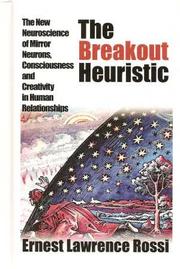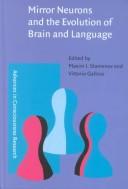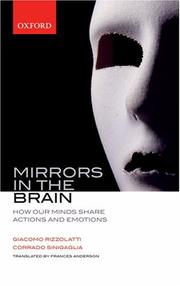| Listing 1 - 10 of 23 | << page >> |
Sort by
|
Book
ISSN: 17644437 ISBN: 9782100543939 2100543938 Year: 2011 Publisher: Paris : Dunod,
Abstract | Keywords | Export | Availability | Bookmark
 Loading...
Loading...Choose an application
- Reference Manager
- EndNote
- RefWorks (Direct export to RefWorks)
Brain --- Psychophysiology --- Mirror Neurons --- physiology --- Brain - physiology

ISBN: 9781932248296 Year: 2007 Publisher: Phoenix, AZ : Milton H. Erickson Foundation Press,
Abstract | Keywords | Export | Availability | Bookmark
 Loading...
Loading...Choose an application
- Reference Manager
- EndNote
- RefWorks (Direct export to RefWorks)
Consciousness. --- Hypnotism --- Mirror neurons. --- Neurosciences. --- Psychotherapy. --- Therapeutic use.
Book
ISBN: 9780198871705 0198871708 Year: 2023 Publisher: Oxford Oxford University Press
Abstract | Keywords | Export | Availability | Bookmark
 Loading...
Loading...Choose an application
- Reference Manager
- EndNote
- RefWorks (Direct export to RefWorks)
'Mirroring Brains' combines neuroscience, psychology and philosophy to provide a comprehensive account of one of the most intriguing discoveries of the last 30 years - the discovery of mirror neurons. These neurons are characterised by firing both when someone performs an action, and also when they observe the same action being performed by others. Whereas it was widely regarded as characteristic of only a small subset of neurons, recent discoveries have shown that the mirror property is a fundamental principle of the functioning of the whole brain. Exploring this discovery, the authors explain how we are able to immediately understand others' actions and emotions, providing a deeper understanding of how we relate to each other and introducing the idea of 'understanding from the inside'. An essential read for neuroscientists, psychologists, philosophers and sociologists.--
Philosophical anthropology --- Affective and dynamic functions --- Mirror neurons
Book
ISBN: 9780393089615 0393089614 Year: 2014 Publisher: New York, N.Y. Norton
Abstract | Keywords | Export | Availability | Bookmark
 Loading...
Loading...Choose an application
- Reference Manager
- EndNote
- RefWorks (Direct export to RefWorks)
"In The Myth of Mirror Neurons, neuroscientist Gregory Hickok reexamines the mirror neuron story and finds that it is built on a tenuous foundation--a pair of codependent assumptions about mirror neuron activity and human understanding. Drawing on a broad range of observations from work on animal behavior, modern neuroimaging, neurological disorders, and more, Hickok argues that the foundational assumptions fall flat in light of the facts. He then explores alternative explanations of mirror neuron function while illuminating crucial questions about human cognition and brain function: Why do humans imitate so prodigiously? How different are the left and right hemispheres of the brain? Why do we have two visual systems? Do we need to be able to talk to understand speech? What's going wrong in autism? Can humans read minds? The Myth of Mirror Neurons not only delivers an instructive tale about the course of scientific progress--from discovery to theory to revision--but also provides deep insights into the organization and function of the human brain and the nature of communication and cognition." -- Publisher's description.
Cognitive psychology --- Physiology of nerves and sense organs --- Mirror neurons. --- Brain --- Cognitive neuroscience. --- Neurones miroirs --- Cerveau --- Neurosciences cognitives --- Physiology. --- Physiologie --- Mirror neurons --- Cognitive neuroscience --- Mirror Neurons --- Physiology --- Brain - Physiology

ISBN: 9027251622 9027251665 1588112152 158811242X 9786612161643 1282161644 9027297088 9789027297082 9781588112422 9789027251664 9781588112156 9789027251626 Year: 2002 Publisher: Amsterdam Benjamins
Abstract | Keywords | Export | Availability | Bookmark
 Loading...
Loading...Choose an application
- Reference Manager
- EndNote
- RefWorks (Direct export to RefWorks)
The emergence of language, social intelligence, and tool development are what made homo sapiens sapiens differentiate itself from all other biological species in the world. The use of language and the management of social and instrumental skills imply an awareness of intention and the consideration that one faces another individual with an attitude analogical to that of one's own. The metaphor of 'mirror' aptly comes to mind.Recent investigations have shown that the human ability to 'mirror' other's actions originates in the brain at a much deeper level than phenomenal awareness.
Psycholinguistics --- Brain --- Mirror neurons. --- Evolution. --- Brain -- Evolution. --- Language and languages. --- Neural circuitry.
Book
ISBN: 9782738119247 Year: 2008 Publisher: Paris : O. Jacob,
Abstract | Keywords | Export | Availability | Bookmark
 Loading...
Loading...Choose an application
- Reference Manager
- EndNote
- RefWorks (Direct export to RefWorks)
Une synthèse de la découverte des neurones miroirs et les perspectives qu'elle ouvre sur les mécanismes des comportements sociaux : langage, émotions, compréhension des autres.
Mirror neurons --- Human behavior --- Neurophysiology --- Brain --- Neurones miroirs --- Comportement humain --- Neurophysiologie --- Cerveau --- Physiology --- Physiologie
Book
Year: 2018 Publisher: Frontiers Media SA
Abstract | Keywords | Export | Availability | Bookmark
 Loading...
Loading...Choose an application
- Reference Manager
- EndNote
- RefWorks (Direct export to RefWorks)
Since the beginning of the 20th Century, phenomenology has developed a distinction between lived body (Leib) and physical body (Koerper), a distinction well known as body-subject vs. body-object (Hanna and Thompson 2007). The lived body is the body experienced from within - my own direct experience of my body lived in the first-person perspective, myself as a spatiotemporal embodied agent in the world. The physical body on the other hand, is the body thematically investigated from a third person perspective by natural sciences as anatomy and physiology. An active topic affecting the understanding of several psychopathological disorders is the relatively unknown dynamic existing between aspects related to the body-object (that comprises the neurobiological substrate of the disease) and the body-subject (the experiences reported by patients) (Nelson and Sass 2017). A clue testifying the need to better explore this dynamic in the psychopathological context is the marked gap that still exists between patients’ clinical reports (generally entailing disturbing experiences) and etiopathogenetic theories and therapeutic practices, that are mainly postulated at a bodily/brain level of description and analysis. The phenomenological exploration typically targets descriptions of persons’ lived experience. For instance, patients suffering from schizophrenia may describe their thoughts as alien (‘‘thoughts are intruding into my head’’) and the world surrounding them as fragmented (‘‘the world is a series of snapshots’’) (Stanghellini et al., 2015). The result is a rich and detailed collection of the patients’ qualitative self-descriptions (Stanghellini and Rossi, 2014), that reveal fundamental changes in the structure of experiencing and can be captured by using specific assessment tools (Parnas et al. 2005; Sass et al. 2017; Stanghellini et al., 2014). The practice of considering the objective and the subjective levels of analysis as separated in the research studies design has many unintended consequences. Primarily, it has the effect of limiting actionable neuroscientific progress within clinical practice. This holds true both in terms of availability of evidence-based treatments for the disorders, as well as for early diagnosis purposes. In response to this need, this collection of articles aims to promote an interdisciplinary endeavor to better connect the bodily, objective level of analysis with its experiential corollary. This is accomplished by focusing on the convergence between (neuro) physiological evidence and the phenomenological manifestations of anomalous bodily experiences present in different disorders.
Phenomenology --- Anorexia --- Mirror neurons system --- Self disorders --- multisensory integration --- Schizophrenia --- embodiment --- Psychopathology --- anomalous bodily experiences --- Neurophysiology
Book
Year: 2018 Publisher: Frontiers Media SA
Abstract | Keywords | Export | Availability | Bookmark
 Loading...
Loading...Choose an application
- Reference Manager
- EndNote
- RefWorks (Direct export to RefWorks)
Since the beginning of the 20th Century, phenomenology has developed a distinction between lived body (Leib) and physical body (Koerper), a distinction well known as body-subject vs. body-object (Hanna and Thompson 2007). The lived body is the body experienced from within - my own direct experience of my body lived in the first-person perspective, myself as a spatiotemporal embodied agent in the world. The physical body on the other hand, is the body thematically investigated from a third person perspective by natural sciences as anatomy and physiology. An active topic affecting the understanding of several psychopathological disorders is the relatively unknown dynamic existing between aspects related to the body-object (that comprises the neurobiological substrate of the disease) and the body-subject (the experiences reported by patients) (Nelson and Sass 2017). A clue testifying the need to better explore this dynamic in the psychopathological context is the marked gap that still exists between patients’ clinical reports (generally entailing disturbing experiences) and etiopathogenetic theories and therapeutic practices, that are mainly postulated at a bodily/brain level of description and analysis. The phenomenological exploration typically targets descriptions of persons’ lived experience. For instance, patients suffering from schizophrenia may describe their thoughts as alien (‘‘thoughts are intruding into my head’’) and the world surrounding them as fragmented (‘‘the world is a series of snapshots’’) (Stanghellini et al., 2015). The result is a rich and detailed collection of the patients’ qualitative self-descriptions (Stanghellini and Rossi, 2014), that reveal fundamental changes in the structure of experiencing and can be captured by using specific assessment tools (Parnas et al. 2005; Sass et al. 2017; Stanghellini et al., 2014). The practice of considering the objective and the subjective levels of analysis as separated in the research studies design has many unintended consequences. Primarily, it has the effect of limiting actionable neuroscientific progress within clinical practice. This holds true both in terms of availability of evidence-based treatments for the disorders, as well as for early diagnosis purposes. In response to this need, this collection of articles aims to promote an interdisciplinary endeavor to better connect the bodily, objective level of analysis with its experiential corollary. This is accomplished by focusing on the convergence between (neuro) physiological evidence and the phenomenological manifestations of anomalous bodily experiences present in different disorders.
Phenomenology --- Anorexia --- Mirror neurons system --- Self disorders --- multisensory integration --- Schizophrenia --- embodiment --- Psychopathology --- anomalous bodily experiences --- Neurophysiology

ISBN: 9780199217984 019921798X Year: 2006 Publisher: Oxford Oxford university press
Abstract | Keywords | Export | Availability | Bookmark
 Loading...
Loading...Choose an application
- Reference Manager
- EndNote
- RefWorks (Direct export to RefWorks)
Motor Activity --- Mirror neurons. --- Neurones miroirs --- Philosophical anthropology --- Affective and dynamic functions --- Cognitive neuroscience. --- Brain --- Cognition --- Neurons --- Neurosciences cognitives --- physiology. --- Cognitive neuroscience --- Mirror neurons --- Cognitive neuropsychology --- Cognitive science --- Neuropsychology
Book
Year: 2018 Publisher: Frontiers Media SA
Abstract | Keywords | Export | Availability | Bookmark
 Loading...
Loading...Choose an application
- Reference Manager
- EndNote
- RefWorks (Direct export to RefWorks)
Since the beginning of the 20th Century, phenomenology has developed a distinction between lived body (Leib) and physical body (Koerper), a distinction well known as body-subject vs. body-object (Hanna and Thompson 2007). The lived body is the body experienced from within - my own direct experience of my body lived in the first-person perspective, myself as a spatiotemporal embodied agent in the world. The physical body on the other hand, is the body thematically investigated from a third person perspective by natural sciences as anatomy and physiology. An active topic affecting the understanding of several psychopathological disorders is the relatively unknown dynamic existing between aspects related to the body-object (that comprises the neurobiological substrate of the disease) and the body-subject (the experiences reported by patients) (Nelson and Sass 2017). A clue testifying the need to better explore this dynamic in the psychopathological context is the marked gap that still exists between patients’ clinical reports (generally entailing disturbing experiences) and etiopathogenetic theories and therapeutic practices, that are mainly postulated at a bodily/brain level of description and analysis. The phenomenological exploration typically targets descriptions of persons’ lived experience. For instance, patients suffering from schizophrenia may describe their thoughts as alien (‘‘thoughts are intruding into my head’’) and the world surrounding them as fragmented (‘‘the world is a series of snapshots’’) (Stanghellini et al., 2015). The result is a rich and detailed collection of the patients’ qualitative self-descriptions (Stanghellini and Rossi, 2014), that reveal fundamental changes in the structure of experiencing and can be captured by using specific assessment tools (Parnas et al. 2005; Sass et al. 2017; Stanghellini et al., 2014). The practice of considering the objective and the subjective levels of analysis as separated in the research studies design has many unintended consequences. Primarily, it has the effect of limiting actionable neuroscientific progress within clinical practice. This holds true both in terms of availability of evidence-based treatments for the disorders, as well as for early diagnosis purposes. In response to this need, this collection of articles aims to promote an interdisciplinary endeavor to better connect the bodily, objective level of analysis with its experiential corollary. This is accomplished by focusing on the convergence between (neuro) physiological evidence and the phenomenological manifestations of anomalous bodily experiences present in different disorders.
Phenomenology --- Anorexia --- Mirror neurons system --- Self disorders --- multisensory integration --- Schizophrenia --- embodiment --- Psychopathology --- anomalous bodily experiences --- Neurophysiology --- Phenomenology --- Anorexia --- Mirror neurons system --- Self disorders --- multisensory integration --- Schizophrenia --- embodiment --- Psychopathology --- anomalous bodily experiences --- Neurophysiology
| Listing 1 - 10 of 23 | << page >> |
Sort by
|

 Search
Search Feedback
Feedback About UniCat
About UniCat  Help
Help News
News